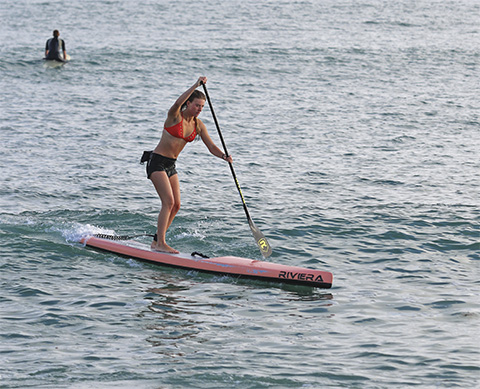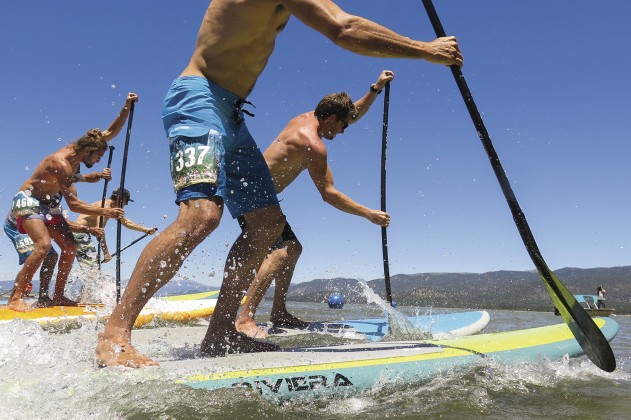THE TRUTH ABOUT CORE
Words: Kate Starling • Photos: Mike Muir
Ask most people about the health and fitness benefits of SUP and one of the main things they’ll say is that not only does it increase overall stamina, endurance and strength but it also increases ‘core stability’ or ‘core strength’. These days we’re all so used to hearing the word ‘core’ but what is the core really? What does it do and how do we engage it to get the most out of SUP? Let’s focus in on the more technical side of it.
WHAT IS THE CORE?
The spine, hips, pelvis, proximal lower limbs (i.e. upper arms and thighs) and abdominal structures all form the musculoskeletal core of the body. It’s common to believe several things about the core. Firstly, that the core muscles are formed by all of the trunk muscles which surround our midriff. Secondly, that having a well-defined six pack means that you have a strong core. And thirdly, doing abdominal crunches, oblique crunches, deadlifts and spinal extension exercises are going to target and strengthen the core muscles. All of these are misconceptions. If you’re lucky enough to have a six pack this is due to a toned rectus abdominis muscle and whilst this may look good, it isn’t classed as a core muscle. Instead, the rectus abdominis together with the internal and external obliques are abdominal muscles whilst the erector spinae is a lumbar muscle. The abdominal and lumbar muscles are situated closer to the skin and are global dynamic muscles which provide general stabilisation and trunk movement. However, they do not contribute to true core or postural stability! Instead, the core musculature consists of four key muscles: the transversus abdominis, the multifidus, the pelvic floor and the diaphragm. These muscles are situated deep to the more superficial abdominal and lumbar muscles.
Imagine a box which sits between the bottom of your ribcage and the bottom of your pelvis and runs from your stomach through to your lower back. The transverse abdominis is the deepest abdominal muscle and forms a ‘corset’ around the lumbar spine and pelvis. In normal activation, this muscle anticipates body movement and contracts to help protect the spinal joints, ligaments, discs and nerves. When functioning properly, it is therefore intrinsic in helping to prevent lower back pain. This muscle sits at the ‘front of the box’.
The multifidus muscles attach to the transverse processes (on the sides) of one vertebra and run up the spinous processes (the middle) of the vertebrae above. These muscles are short in length so do not produce a large range of movement. Instead, they work to produce small, ‘fine tuning’ postural adjustments to promote back stability. This muscle forms the ‘back of the box’.
At the ‘roof’ or ‘top of the box’ sits the diaphragm. Simultaneous contraction of the transversus abdominus, pelvic floor muscles and the diaphragm increases the pressure within the abdomen, providing increased trunk and spinal stability prior to limb movement. Diaphragmatic activation occurs independently of respiration.
Finally, the pelvic floor muscles form the ‘floor’ or ‘bottom of the box’. These muscles contract synergistically with the transversus abdominis, multifidus and diaphragm to provide a base of support for all of the trunk and spinal muscles.

WHAT DOES THE CORE DO?
The four core muscles are responsible for maintaining spinal and pelvic stability and helping to generate and transfer energy from large to small body parts. The core muscles together with the spinal, hip and pelvic joints are positioned centrally so that they can provide the important function of proximal stability for distal limb movement. In other words, in any activity, the core seeks to provide central stability when we move our arms and legs either towards us or away from us. Not only is maintaining a strong core essential to provide local strength and balance, but critically, the control of core strength, balance and motion is key in maximising all upper and lower extremity function.
Virtually every time we move our extremities, the core should be involved. So whether we walk, sit, place our hands above our head or turn over in bed, the core should provide stability for movement. If you still need convincing, the muscles which play a major role in the movement of the arms and legs all attach to the core of the pelvis and the spine. They include the latissimus dorsi, pectoralis major, hamstrings, quadriceps and iliopsoas muscles. Most of the major stabilising muscles for the extremities also attach to the core, including the upper and lower trapezius, hip rotators and gluteal muscles. The core therefore could not be more important and fundamental to all of our movements. Without a strong core, we fail to optimise the stability and therefore the function, strength and movement of our arms and legs which in turn can increase our risk of injury.
YOU CANNOT STRENGTHEN WHAT YOU CANNOT ACTIVATE:
Normally, core muscles should activate before initiation of limb movement to provide the necessary stability for the movement to occur. However, if you have mid or lower back pain, have had any abdominal injury or surgery, are post-natal or are de-conditioned, the anticipatory activation of the core muscles can be absent or delayed, resulting in dysfunction. Jumping onto a SUP board and presuming a paddling session is going to instantly start to increase your core stability therefore isn’t necessarily true. This is because you cannot strengthen a muscle which your brain is unable to activate. In order to activate the core successfully, the recruitment pattern (the order in which different muscles contract) of the core must be restored. The first step therefore is to isolate the transverse abdominis muscle and train it to contract. Try the following to achieve a deep and isolated transverse abdominis contraction:
Lie on your back with your spine in a neutral posture so that you have a gentle curve in your lower back.
Place your fingers on the left and right hip bones – these are the bony prominences at the front of your hips. Slide your fingers in by a couple of centimetres into a small dip. Then slide your fingers down by a couple of centimetres towards your groin.
To cue the muscle contraction, imagine one of the following:
- Imagine you have a ‘zip’ running from your tailbone all the way to the front of your pelvis. Imagine doing this ‘zip’ up, working from back to front.
- Contract your pelvic floor by drawing the muscles from behind your pubic bone to your tail bone and the left and right sides of your pelvic floor together and then like a draw string bag, gently draw the entire pelvic floor up.
As you contract the transverse abdominis you should feel the muscle contraction under your fingertips. This should feel like a light, deep tension. It should not push your fingers out and there should be no movement in your hips, pelvis or spine.
Hold the contraction for 5 seconds and then release. Repeat for 3 sets of 10 repetitions, 3 times daily for 4 weeks.
Often, if there is dysfunction in the core, it is common for other muscles to co-contract in compensation. Ensure there is no:
- Posterior pelvic tilting (flattening of the lumbar spine)
- Abdominal bulging/doming
- Rib cage depression
- Breath holding
- Fingertips being pressed out by a strong muscular contraction (caused by the internal oblique muscle)
The better you are at isolating this muscle, the faster it will integrate into functional activities. Once you are able to achieve a good isolated contraction you can begin to challenge your core more functionally. Start loading through your arms and legs in the following ways:
- Practice standing on a flat surface holding your paddle. Activate your core and perform a small static knee bend.
- Repeat step one. This time, extend your arms as if you are about to place your paddle in the water.
- Then, practice a more dynamic movement. Activate your core and as you do so practice a full paddle stroke on dry land, keep your core activated throughout.
Once you are able to achieve good dynamic movement on a dry and stable surface it’s time to challenge your core further through SUP specific training out on the water.
CORE STABILITY AND SUP:
Standing on a SUP board, moving the paddle through the water and moving your arms through the air provides a constant postural challenge. When you SUP, the unstable surface of the water requires the core muscles to contract to provide stability whilst the muscles in the legs, arms, back, feet and toes work to maintain balance. Throughout the reach, catch, power and recovery phase numerous muscles contract: the latissimus dorsi, pectoralis major, hamstrings, quadriceps, iliopsoas muscles, upper and lower trapezius, hip rotators and gluteal muscles, to name but a few. As these major muscles connect to the core, training on an unstable surface requires increased core activation resulting in increased motor control and strength. It also helps to develop power within the core. This is because, the stronger the core, the more stable the base. And the more stable the base is the more power can be generated. This encourages a more efficient paddle stroke together with increased speed. Meanwhile, to train core muscle endurance requires increasingly unstable surfaces. Paddling on choppy water, against the tide, wind or in waves challenges the core muscles further. Developing core muscle endurance over time is important so that you can spend more time out on the water without losing form and fatiguing. Above all, training and strengthening the core requires repetitive use. Therefore the more you use it, the less likely you will be to lose it. Get out, start paddling and switch your core on.

